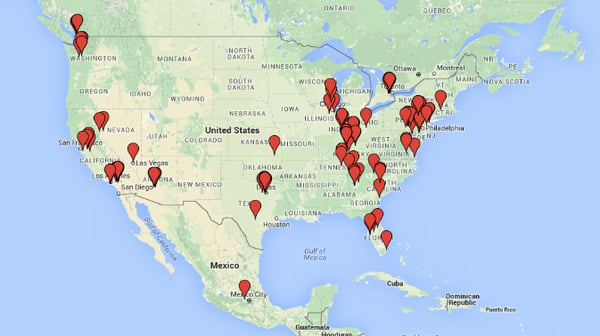Many brands who are considering selling on Amazon are eager to find out where Amazon’s Fulfillment Centers (warehouses) are located, so they can figure out which is the closest fulfillment center to send their inventory to.
Unfortunately, it doesn’t work like that.
Amazon has over 100 Fulfillment Centers in the US alone, based on our current estimate from sources like job listings, and inbound shipping information. This is just an estimate, because Amazon does not publish the locations of their warehouses.
Click here to see the interactive Google Maps summary all Amazon’s Fulfillment Centers that we’ve identified in North America.
But despite Amazon having locations all around the country, as a seller you cannot choose which location your inventory ships to. Instead, Amazon uses its advanced software to determine the most effective location to ship your inventory to, based on your location, and efficiently disburses your products to where customers are located. In some cases, it means that Amazon’s system will tell you to send specific quantities of inventory to multiple Fulfillment Centers.
This is frustrating for some sellers who are concerned about their Sales Tax Nexus and keeping their freight costs low. There is a service which may help somewhat, called the Inventory Placement Service.
Amazon's shipping algorithm ordinarily determines where your inventory will be placed, but if you wish to specify where it will go, you must pay an additional fee per unit, ranging from $0.30 to more than $1.30 per unit. Even when using the Inventory Placement Service, you cannot choose the fulfillment center to which your inventory is routed. It just means that Amazon will select just 1 Fulfillment Center to send your inventory, instead of several.
Ultimately, the only way to know which FC(s) Amazon will require your inventory to be sent to is to create the product listing, and then create a shipment.
You’ll need to provide Amazon with the address where the shipment is coming from (i.e. the manufacturing facility, or the US address of your freight forwarder, the quantity of case-packs and number of units in case-packs. When you click "Create Shipment", Amazon's system will then tell you which fulfillment center(s) they want you to ship to.
Companies importing products from other countries like China, might also be eager to know what address to ship their inventory to. Again, you’ll only be able to determine the address to ship your products to once you have uploaded your product listings to Amazon, and created a new inbound shipment via Seller Central (or received a Purchase Order through Vendor Central or Vendor Express).
When importing, you must not list Amazon as the Importer Of Record or Consignee; they will reject the shipment and it will be destroyed or returned to you at your expense. Read more about the process that international sellers & companies importing product into the US should follow to start selling on Amazon.
Need help? Our team of Amazon Experts help brands to launch products and grow revenue on Amazon. Read about our service and contact us to see if we’re the right fit to help build & grow your brand’s Amazon channel.
.png)


